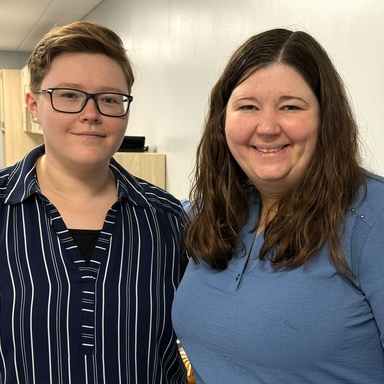
On April 22, 2025, Alix McCullough, a graduate student in the Microbiology Graduate Program, effectively defended their PhD thesis entitled "Characterizing Interactions Between Chlamydia trachomatis Type III Secreted Effector TmeA and Modulators of the Actin Cytoskeleton During Early Host Cell Infection.” They are pictured with their mentor, Mary Weber, PhD.
Research
Chlamydia trachomatis (C.t.) is a bacterial pathogen that represents a significant health burden in the United States and worldwide. C.t. causes an eye infection, trachoma, and the sexually transmitted infections (STIs) chlamydia and lymphogranuloma venerium. Trachoma is the leading cause of infectious blindness worldwide, while the STIs can lead to severe complications including cancer and infertility.
C.t. is an obligate intracellular bacterium, meaning that it must be able to invade human cells to replicate and cause disease. My work identifies one method C.t. uses to invade host cells, centered around a C.t. protein, TmeA. TmeA is injected when C.t. binds to the outer membrane of human cells. TmeA then recruits and activates human proteins, driving signaling that causes the human cell to engulf the bacterium.
I identified two human proteins, N-WASP and TOCA-1, that are bound by TmeA during early stages of infection. TmeA binds and activates N-WASP as a mimic of its native activator, Cdc42. This interaction drives actin branching and ultimately uptake of the bacterium through recruitment and activation of the Arp2/3 complex. In addition, TmeA directly binds TOCA-1, and both TOCA-1 and N-WASP play an additional role in generation of pedestal-like structures associated with the bacterium before it invades the host cell.
Collectively, this work provides new insight into how Chlamydia trachomatis invades human cells and highlights a critical step in its pathogenic lifecycle.
Background
Alix was born in Des Moines, Iowa, and is the third of four children born to Steve and Beth McCullough. Alix’s interest in the natural world started during preschool, when their favorite activity was searching for insects at recess. Their love of animals, from dogs and hedgehogs to snakes and bugs, grew into a fascination with biological sciences and eventually led them to the University of Iowa.
Alix pursued an undergraduate degree in Microbiology with the intention of applying to medical school. Instead, they were bitten by the research bug when they joined the lab of Dr. Mary Weber in 2018. During their undergraduate work, they initially focused on molecular cloning as well as yeast toxicity assays to identify putative Chlamydia trachomatis Type III secreted effector proteins with interesting phenotypes. This led them to their eventual graduate project, unraveling an interesting interaction between an effector called TmeA and a host protein, N-WASP.
Alix chose to remain at the University of Iowa in Dr. Weber’s lab to pursue their PhD. They continued their work studying TmeA’s role in Chlamydia trachomatis invasion of host cells, identifying additional host interactors and potential pre-invasion structures generated by these interactions, as well as determining the molecular underpinnings of the TmeA-N-WASP interaction.
During their time in graduate school, Alix discovered a love for scientific outreach and communication. They have traveled across the state to participate in and lead STEM outreach events, teaching kids, grandparents, and everyone in between about the wonderful world of microbes. They plan to continue to pursue science communication and application scientist roles after graduate school.
When not in the lab, Alix spends their time reading and writing science fiction and fantasy stories and playing video games with their cat, Theodore, and corn snake, Toby. They enjoy playing board games and going on adventures with their brother, Ryan, sister-in-law, Bree, and nephew, James.